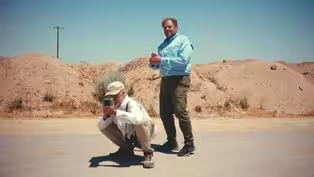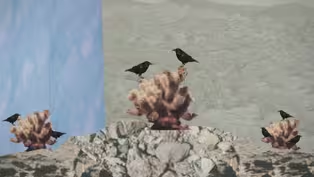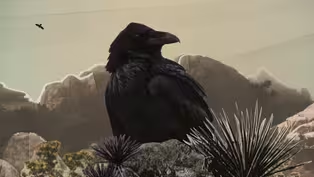
Desert Ravens: A 'Major Relative' to Indigenous Traditions
Clip: Season 5 Episode 3 | 4m 28sVideo has Closed Captions
For Indigenous peoples of the Mojave, ravens are powerful, respected elders.
For Indigenous peoples of the Mojave, the intelligent raven is a powerful, respected elder. Sienna Thomas (Piipaash / Tsitsitas) and Elizabeth Paige (Torres Martinez Band of Cahuilla Indians), attribute an overabundance of ravens to an imbalance in people's behaviors. They explore the raven's impact on desert habitat shared by great horned owl and hawk families.
Problems playing video? | Closed Captioning Feedback
Problems playing video? | Closed Captioning Feedback
Earth Focus is a local public television program presented by PBS SoCal

Desert Ravens: A 'Major Relative' to Indigenous Traditions
Clip: Season 5 Episode 3 | 4m 28sVideo has Closed Captions
For Indigenous peoples of the Mojave, the intelligent raven is a powerful, respected elder. Sienna Thomas (Piipaash / Tsitsitas) and Elizabeth Paige (Torres Martinez Band of Cahuilla Indians), attribute an overabundance of ravens to an imbalance in people's behaviors. They explore the raven's impact on desert habitat shared by great horned owl and hawk families.
Problems playing video? | Closed Captioning Feedback
How to Watch Earth Focus
Earth Focus is available to stream on pbs.org and the free PBS App, available on iPhone, Apple TV, Android TV, Android smartphones, Amazon Fire TV, Amazon Fire Tablet, Roku, Samsung Smart TV, and Vizio.
Providing Support for PBS.org
Learn Moreabout PBS online sponsorshipFor the Indigenous peoples of the Mojave, ravens provide insight into balance in the desert ecosystem and what role we humans play in it.
My name is Sienna Thomas, and I work for the Living Desert as a conservation social scientist where I work with Indigenous youth trying to reconnect them to the land.
The hikes that we do are for Indigenous women because we feel that Indigenous women are teachers.
In life, your mother is your first teacher and so that's where we wanted to take this, is to bring Indigenous women back to the land.
That way they can be those teachers to their children to introduce them to the land and let them know this is our way, this is our land, this is where you belong.
Birds are some relatives that we looked to for our lifeways.
We would monitor them closely.
[Indigenous language] [Indigenous language] Yes.
He says, "Nobody's called me that in 50 years."
It's been a bit.
We always knew where resources were because of them, and then even some of their social behaviors, we kind of adopt that.
In our ways, in my culture in particular, we have bird songs and bird dancing.
It's a very beautiful thing to see and to know that a lot of our life ways came from watching our relatives, and the birds are a major relative.
Ravens are viewed as holding a lot of power, and they're very intelligent.
You could see how we came to that conclusion.
It's like they must be very powerful.
In our way, we feel like they're our ancestors because they've been here longer than us.
They were here before us.
In our creation story, all these things were made before we even stepped into the picture.
It's like you're giving them respect because we always respect our elders.
They are also a symbol for transition.
I think as we're seeing their growth in population, we are also seeing transitions, not only in the natural world, but also in the spiritual world as well.
Last year we had a pair of great horned owls and they had two owlets and we got to enjoy a few months of them.
Hawks, owls, they all share or they all take over each other's nests so it could be could be anybody.
On one of the areas that we manage, we had a pair of great horned owls that had made their nest or they occupied the nest and we had two babies, two owlets were making their way around all spring last year.
This year, not so much.
A couple of the site monitors that we have watching our parcel noted a lot of raven activity.
Whether or not they were making their own nest somewhere and using the great horned owls' nest, it remains a mystery but we know that the owls aren't there and that we have a pretty steady population of a family of ravens in the area.
I appreciate watching any bird and noting their behavior but I was heartbroken that the great horned owls moved out of the neighborhood.
They found another suitable location.
There's been this massive influx of ravens in the Mojave Desert.
It's indicative of a problem, a very real problem of people's behaviors affecting what this animal is depending on in the wild.
The animals are being animals and they're doing what they do.
I think for a lot of people, they need to understand that everything has its cycle and sometimes things get unbalanced but it will always find its way back.
The onus is on people.
We're making all the food available for the ravens.
We're affecting their overabundant population right now.
Yes, that's just one of those things where we have to relearn how to balance everything because we're the ones not living in balance.
It's not the animals, it's us.
Ravenville: Why Birds Flock to Desert Human Wastelands
Video has Closed Captions
Clip: S5 Ep3 | 7m 35s | Desert biologists find non-lethal solutions to control surging raven populations. (7m 35s)
Video has Closed Captions
Clip: S5 Ep3 | 1m 10s | The history of the raven in both culture and nature is complex. (1m 10s)
The Tortoise, the Raven, and Us (Preview)
Video has Closed Captions
Preview: S5 Ep3 | 30s | Ravens threaten Mojave Desert tortoises, and solutions call on shifts in human behavior. (30s)
Providing Support for PBS.org
Learn Moreabout PBS online sponsorshipSupport for PBS provided by:
Earth Focus is a local public television program presented by PBS SoCal


















